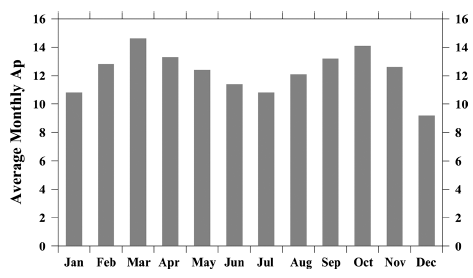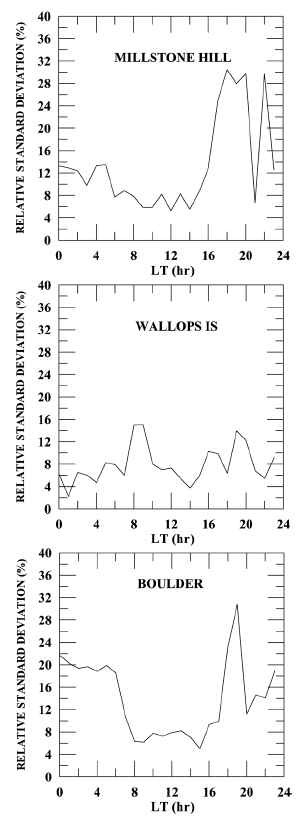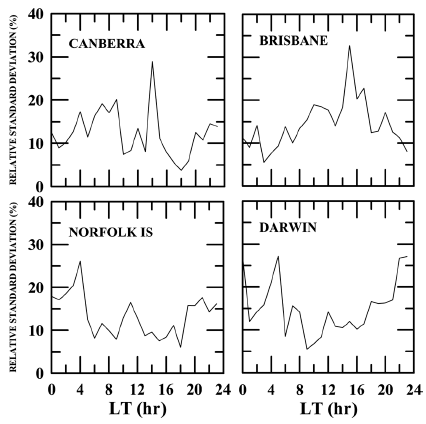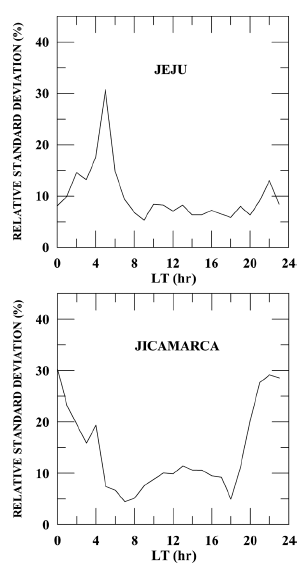1 INTRODUCTION
A traditional topic in ionospheric morphology is the variability of the peak F2-layer electron density NmF2 (e.g., Rishbeth 1993; Forbes et al. 2000; Rishbeth & Mendillo 2001; Kouris & Fotiadis 2002; Wilkinson 2004; Pietrella et al. 2012; Mengist et al. 2016). Possible causes of NmF2 variability are listed by Rishbeth & Mendillo (2001). It has been established that NmF2 is subject to regular and irregular variations. The regular variations of NmF2 include: a) diurnal, season, semiannual, and annual variations that are related to the dependencies of NmF2 on the solar zenith angle and the eccentricity of Earth’s orbit; and b) the variations associated with the 11-year solar activity cycle and the 27-day quasiperiodicity in the rotation of the sun. The irregular variations of NmF2 are mainly related to geomagnetic storms and sub-storms, with some contribution by lower atmosphere forcings (often referred to as “meteorological influences”).
Presently, the key photochemical and physical processes that govern the behavior of the F2 layer are well understood (e.g., Schunk 1988; Rishbeth 1998). Theoretical models can reasonably reproduce the quiet-time variations in NmF2, at least at a single midlatitude site (e.g., Balan et al. 1994; Richards et al. 1994; Anderson et al. 1998), as well as the mean features of season variations in NmF2 (e.g., Millward et al. 1996; Zou et al. 2000). Mathematical models have also been developed to study the storm-time variations of NmF2 (e.g., Fuller-Rowell et al. 1994, 1996, 2000) and the variations of NmF2 associated with lower atmosphere (“meteorological”) impacts (e.g., Mendillo et al. 2002). During geomagnetic storms, the NmF2 variations are predominantly connected with large changes in the following: neutral composition and plasma transport produced by storm-time electric fields, neutral wind, and acoustic-gravity waves (e.g., Prölss 1995). Under magnetically quiet conditions, the lower atmosphere can be an important source of NmF2 variability because of upward-propagating tides as well as planetary and gravity waves (Rishbeth 2006).
The statistical analysis by Forbes et al. (2000), who utilized hourly values of NmF2 derived from over 100 ground-based ionosondes during 1967-89, showed that under quiet geomagnetic conditions (Kp < 1), the variability of NmF2 about the mean was about 25-35 % at periods of a few hours to 1-2 days and about 15-20 % at periods between 2 and 30 days at all latitudes. These values are suggested to be a reasonable estimate of NmF2 variability caused by “meteorological influences,” by which Forbes et al. (2000) are referring to ionospheric modification due to sources in the lower atmosphere or inherent nonlinearity of the ionosphere-atmosphere system. According to the results from the TIME-GCM-CCM3 thermosphere–ionosphere– lower atmosphere flux-coupled model (Mendillo et al. 2002), the “meteorological influences” transmitted from the lower atmosphere cause variations in NmF2 on the order of 10–30 % for quiet geomagnetic conditions (Ap=4) at seven midlatitude different sites. It is concluded that the main cause of NmF2 variability is the propagation of planetary waves in the winter hemisphere, particularly the filtering of vertically propagating gravity waves by winds; neutral composition changes also provide some contribution, at least in winter.
In the present work, we analyze hourly values of the critical frequency of the F2-layer (foF2) from a number of ground-based ionosondes to study the day-to day variability of foF2 during the quietest days (Ap=0) of December 2009, which is the most magnetically quiet month during 1987- 2014.
2 DATA
This analysis is based on the hourly foF2 values recorded at 18 ionospheric stations in December 2009. A list of the stations is provided in Table 1. The foF2 data were obtained from the NGDC SPIDR website (http://spidr.ngdc.noaa. gov/spidr/). NmF2 is directly related to foF2 by the equation NmF2 = (4πε0me/e2) f 2 0F2, where ε0, me, and e denote vacuum permittivity, mass of electron, and elementary charge, respectively.
The percentage relative standard deviation S = σ(foF2)/ foF2 (σ is the standard deviation) is used to estimate of the day-to-day variability of foF2. As an indicator of geomagnetic activity we use the geomagnetic index Ap. Daily and monthly values of Ap were obtained from Geomagnetic Indices Bulletin (https://www.ngdc.noaa.gov/stp/solar/onlinepubl. html). The solar activity in December 2009 was very low, with the monthly F10.7 index as small as 74.4.
3 RESULTS AND DISCUSSION
As shown in Fig. 1(b) presented in Rishbeth & Mendillo (2001), variation in the monthly average of Ap for the interval of 1957 through 1995 reveals a minimum in December. The same conclusion can be drawn from Fig. 1 (this study), which shows monthly averages of the Ap index over the years 1987–2014. Dependence of geomagnetic activity on season has been discussed in many papers (e.g., Bartels 1963; Fraser-Smith 1972; Russell & McPherron 1973; Murayama 1974; Green 1984) but has still not been fully explained. The underlying physical mechanisms responsible for this dependence are reviewed by Clúa de Gonzalez et al. (1993). Over the period of 1987 to 2014, minimal geomagnetic activity took place in December 2009, during which the average daily value of Ap was as small as 2. Therefore, it is interesting to study the quiet time day-to-day variability of foF2 during this month. To this end, we used the days of this month with daily Ap=0. These are December 1, 3-4, 8-9, 11 and 29-31.
We first consider the variability of foF2 at Athens, which is a typical midlatitude station. Fig. 2 shows the local time variation of foF2 at Athens for each of the quietest days (Ap=0) in December 2009. As shown, there is noticeable day-to-day variability in foF2 over Athens, even for very quiet days. Fig. 3 compares mean diurnal curves of foF2 for the quietest days of December 2009 and for all other days of the month (for which the average daily Ap=2) at two midlatitude stations in the winter hemisphere (Athens and Boulder) and at two midlatitude stations in the summer hemisphere (Canberra and Grahamstown). Both curves are close to each other at all stations except Canberra. This indicates a very small influence of geomagnetic activity on the monthly mean diurnal variation of foF2 at Athens, Boulder, and Grahamstown in December 2009.
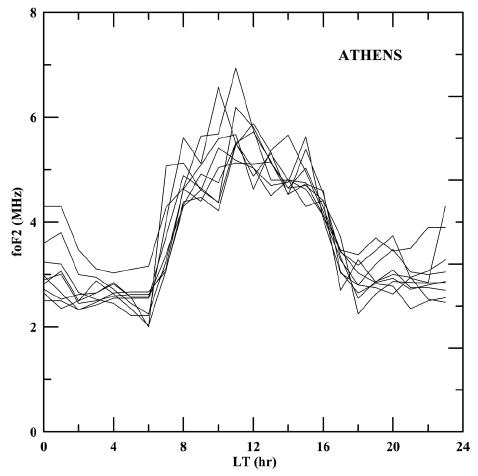
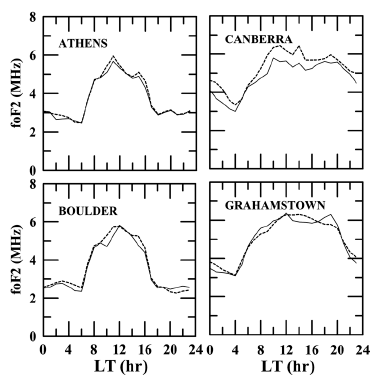
Figs. 4–8 show the percentage relative standard deviations of foF2 about the mean over all the quietest days (Ap=0) in December 2009 at all 18 selected stations. The stations are grouped as follows: Fig. 4 shows the six European midlatitude stations, Fig. 5 shows the three North American stations, Fig. 6 shows the four Australian stations, Fig. 7 shows the two South African midlatitude stations and one South American station, and Fig. 8 shows the two low latitude stations. Each station exhibits significant variability of foF2. In the winter hemisphere, the percentage relative standard deviation S at European high midlatitude stations Juliusruh and Dourbes is minimal (6 % on average) during daytime and maximal at night when S can exceed 20 %. At the lower midlatitude European stations Athens, Rome, de l'Ebre and El Arenosillo, the behavior of S is less regular and different for every station. Notice that the El Arenosillo data show two clear local minima in S around local midnight and noon. At the two North American stations Boulder and Millstone Hill, S is greater at night than during the day. Another North American station, Wallops Is, exhibits smaller values of S compared to Boulder and Millstone Hill, with well-defined peaks during morning and evening hours.
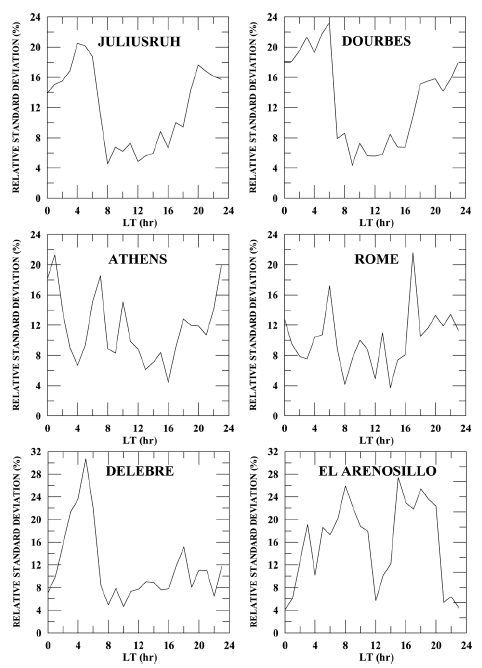
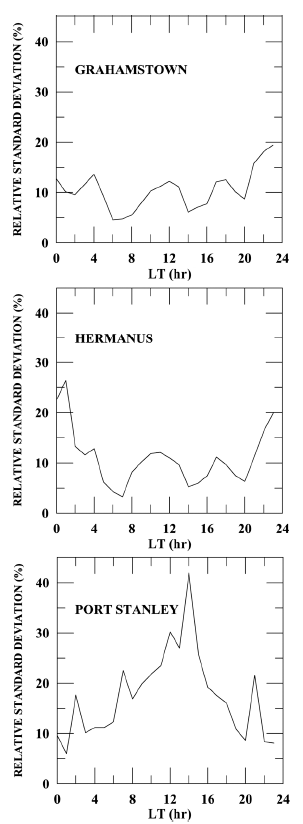
An intercomparison of Figs. 4-7 shows that in the summer hemisphere, the variability of foF2 is on the whole as intense as that in the winter hemisphere. In Australia, S peaked (reaching ~30 %) at about 1400 and 1500 LT at Canberra and Brisbane, respectively, while at Darwin, S had prominent peaks at about 0430 and 2400 LT; at Norfolk Is S peaked at about 0400 LT. The two South African midlatitude stations Grahamstown and Hermanus reveal quasi-periodic LT variations in S with periods of about 6 and 8 hr, respectively. At the South American station Port Stanley, S exceeds 40 % at about 1400 LT. Variability of foF2 at the equatorial station Jicamarca is smaller by day than by night, with a maximum S of ~30 % around midnight. The low latitude station Jeju shows moderate variability during day and night except at about 0500 LT when S attains a narrow peak of ~30 %.
Thus, the results of this case study indicate that there is considerable day-to-day variability of foF2 over the globe under conditions of exceptionally low magnetic activity in December 2009. This is consistent with the study by Forbes et al. (2000) who has attributed the quiet time variability of NmF2 to “meteorological influences,” by which they refer to impact from the lower atmosphere or/and effects related to the intrinsic instabilities of the ionosphere-atmosphere system. The relative importance of these two possible sources of NmF2 variability is still not understood. The magnetically quietest foF2 variability in December 2009 can be prominent at any latitude/longitude and during nighttime and daytime hours, though at some stations the foF2 variability is higher at night than by day. Most stations demonstrate clear peaks in the relative standard deviation S around dawn and dusk, which may be associated with effects of upward propagating gravity waves triggered by the solar terminator (Pietrella et al. 2012).
Short-term (several hours) variability of plasma densities in the F2-layer is mainly caused by changes in the following: plasma drifts associated with neutral winds and electric fields, neutral composition, and temperatures of charged and neutral particles. All these changes can, in principle, be produced by forcings from the lower atmosphere; they could also result from the inherent nonlinearity of the Ionosphere- Atmosphere system. Simulations by Mendillo et al. (2002) have shown that the main contribution to magnetically quiet time NmF2 variability due to effects of the lower atmosphere is produced by fluctuations in neutral winds. The lower atmosphere influences on the F2-layer are damped by molecular diffusion, thermal conductivity, and ion drag. The scale of coherence of the patterns of the NmF2 variability due to the lower atmosphere can be as large as 2,500 km, which is presumably an upper estimate of the scale of perturbations related to the lower atmosphere. In our case, as shown in Fig. 4, the foF2 variabilities at Delebre and El Arenosillo show no resemblance despite the fact that the distance between the stations is much less than 2,500 km.
4 CONCLUSION
We have presented a case study of the day-to-day foF2 variability at a number of 18 ionosonde stations throughout the world during the exceptionally magnetically quiet (Ap=0) days of December 2009, which is one of the quietest (monthly Ap=2) months over the last eight decades. The case under consideration is an excellent opportunity to see the variability in the F2 layer with the smallest contribution by geomagnetic activity. We found that the magnetically quietest time foF2 variability in December 2009 (quantified as the relative standard deviation of foF2) is considerable at any latitude/ longitude, and it can be significant both at night and during the day. At most stations, the foF2 variability presumably reflects the influence of the passage of the solar terminator at sunrise/sunset. Patterns of foF2 variability are different at different stations, even if the stations are located close to each other. On the whole, the presented results are consistent with those of previous studies, such that under “zero-Ap” conditions, there is still significant residual variability in foF2 throughout the globe. Following previous authors, we suggest that the observed diurnal foF2 variability is caused by influences of the lower atmosphere or/and effects of the intrinsic instabilities of the ionosphere-atmosphere system.
